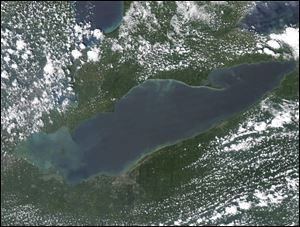
IMPROVING LAKE ERIE
Statehouse tries to change adverse watershed effects
11/14/2014
The algae bloom in Lake Erie on July 31.
COLUMBUS — Environmental organizations on Thursday balked at legislative tinkering with Ohio’s compact with other Great Lakes states and Canada over how the state measures adverse impacts to the watershed.
The provision is one of a number of changes made to a bill that previously dealt chiefly with environmental effects from fertilizer runoff and oil and natural gas drilling.
House Bill 490 is expected to come to a full House vote next week, marking the first legislative response to the toxic algal bloom on Lake Erie that led to Toledo’s drinking water crisis more than three months ago.
Josh Knights, executive director of the Nature Conservancy of Ohio, questioned the addition of new language to Ohio’s implementation of the Great Lakes-St. Lawrence River Basin Water Resources Compact. The language would have Ohio measure adverse impacts to the watershed based on annual runoff from Ohio’s side of the Lake Erie basin.
Similar language had been included in the General Assembly’s first pass at establishing Ohio’s water withdrawal thresholds from the lake that Gov. John Kasich vetoed in 2011. The bill the governor signed a year later included a study committee on the issue.
“It’s as if that work had never happened, and this is a throwback to basically the standard that the governor vetoed…,” Mr. Knights said. “If you’re taking a lot of water out because you’re doing a lot of hydraulic fracturing up in northeast Ohio, you take it out of a small stream, and it’s not 1 percent of the entire watershed, you’re good. There’s no significant impact even though you may have just sucked that stream dry.”
State Rep. Dave Hall (R., Millersburg), the bill’s sponsor and chairman of the House Agriculture and Natural Resources Committee, said the compact language was added to try to jump start the stalled issue.
“I think we have a stalemate right now,” he said. “We’re trying to push the issue more than anything else.”
As for addressing the algal bloom problem, the bill calls for a study of the sources of nutrient discharges into Ohio watersheds and the crafting of a state definition of a “watershed in distress.”
The state would be required to establish “technically feasible” and “economically reasonable” standards and create nutrient management plans to reduce runoff into distressed watersheds. The plans also would address the timing of manure application to farmland, but the bill does not set deadlines for state action.
In the meantime, Mr. Hall said his committee will not adopt a proposed amendment from State Rep. Mike Sheehy (D., Oregon) to prohibit manure application on frozen or saturated ground. Many farmers, he said, don’t have the facilities to safely store manure.
“We can’t put diapers on farm animals right now,” he said. “What I envision is farmers down the road, with no or low-interest loans or some kind of grant program, will have the ability to have holding tanks for their manure operations.”
Mr. Hall promised that heavier lifting on nutrient runoff and algal blooms will take place in the next two-year session.
“It’s not about the drinking water,” said Mr. Sheehy, a committee member. “It’s about the economic vitality of an entire region. … This is where it starts. It starts right here.”
Contact Jim Provance at: jprovance@theblade.com or 614-221-0496.